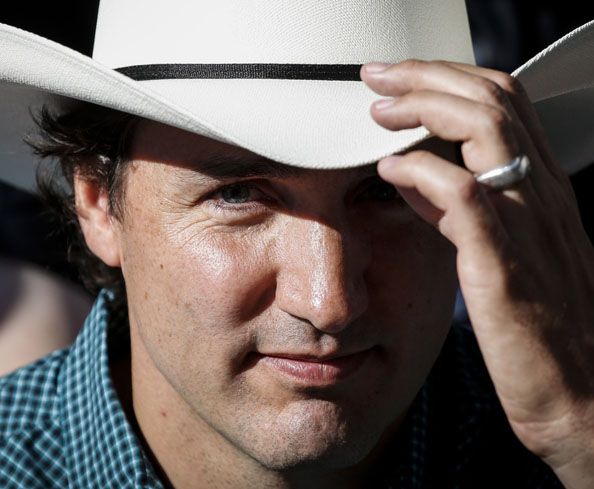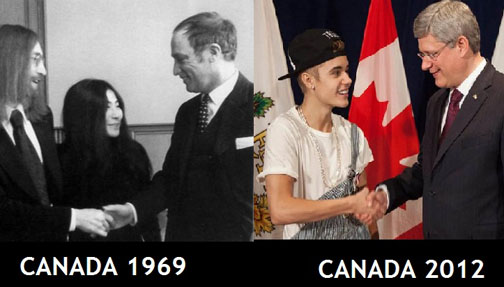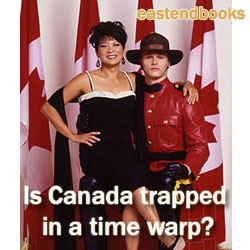A new moment of truth for Justin Trudeau .. what will he do?
Apr 17th, 2015 | By Randall White | Category: In Brief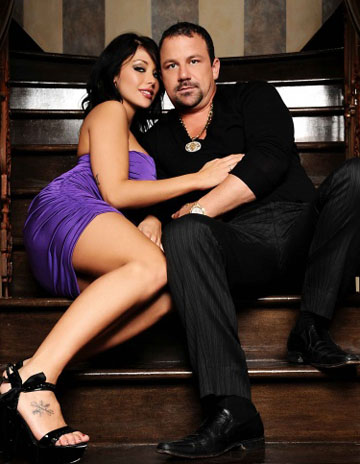
Éric Grenier, accompagné d'une fille du Garage, lors de la promotion du docu-réalité Le bum, les belles et la brute. Alas, this is NOT the Éric Grenier who tries to make sense of federal and provincial political polls in Canada. But the professional poker playing Éric Grenier from Quebec pictured here may be an important swing voter in federal elections!
This past Wednesday Éric Grenier almost dramatically announced on the CBC News site : “Justin Trudeau’s Liberals lose lead to Tories for 1st time in 2 years.”
The helpful chart that traces opinion polls on Canadian federal politics since the last election in May 2011 – in the Wikipedia article “Opinion polling for the 42nd Canadian federal election” – Â serves as instructive background here.
Justin Trudeau became the new leader of the Liberal Party of Canada on April 14, 2013. At almost exactly the same time the federal Liberals moved ahead of both the New Democrats and the Conservatives, to lead in the polls. And, through recurrent ups and downs in exact numbers, they remained in first place with some consistency until quite recently.
In fact, various individual polls have shown the Harper Conservatives regaining the lead since as long ago as just before this past Christmas 2014. Â But the Liberals have also bounced back into first place a few times since then.
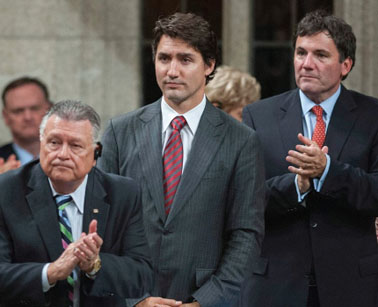
Liberal Leader Justin Trudeau, supported by Ralph Goodale from Saskatchewan and Dominic LeBlanc from New Brunswick, votes against an air combat mission against ISIS in the Canadian House of Commons on October 7, 2014. Already at that point Éric Grenier was noting that polls were suggesting Trudeau “may be politically vulnerable over his decision not to support the government motion authorizing Canada's mission.” (Justin Tang/Canadian Press.)
What  Éric Grenier is alluding to now, in the middle of April 2015, involves his systematic averages of all major public polls.  Heretofore the Liberals have been at least narrowly prevailing in the polling averages. However, as of April 13, the Grenier averages have now found the Harper Conservatives narrowly prevailing, with 32% support, compared to 31%  for the Trudeau Liberals, and 22% for the Mulcair New Democrats.
If you’re wondering about the broader dynamics here, down on the ground, Mr./M. Grenier has words of wisdom on this as well. Very briefly, it’s not that the Conservatives are suddenly doing better. It’s that the Liberals are doing worse – and their votes, as it were, are going to the New Democrats (at last, at last, some will say). Or, in Éric Grenier’s own words : “Stephen Harper’s Conservatives have swapped positions with the Liberals almost by default.”
1. Are progressives really migrating from Liberals to New Democrats ??
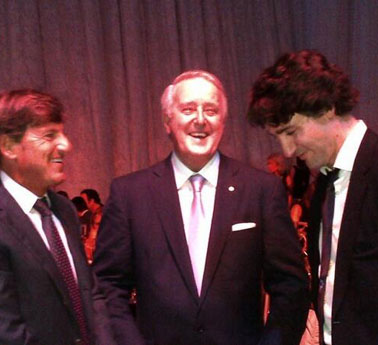
Justin Trudeau with Brian Mulroney and Stephen Bronfman at Montreal social event. Stephen Bronfman, “de la famille Bronfman, riche famille d'industriels montréalais,” was chief fundraiser for Trudeau’s Liberal leadership campaign, and is now chief fundraiser for the Liberal Party of Canada.
One possibly too obvious ideological deduction here is that the Trudeau Liberals of 2015 have been losing ground lately because they have been taking a few too many steps to the centre-right, pushing their more progressive voters into the more-than-waiting arms of Tom Mulcair’s New Democrats. Â (Yes, that same federal NDP leader Thomas Mulcair : the one who was a cabinet minister in a Quebec Liberal government.)
Or in the rightly more guarded words of Éric Grenier’s analysis : “Trudeau’s party was polling at between 33 and 34 per cent for the first three months of the year, but has been dropping over the last three weeks … This is taking place as the New Democrats put together their most positive string of polls in more than a year. That was the last time the NDP managed at least 23 to 25 per cent support in four consecutive polls, the same streak they are currently riding.”
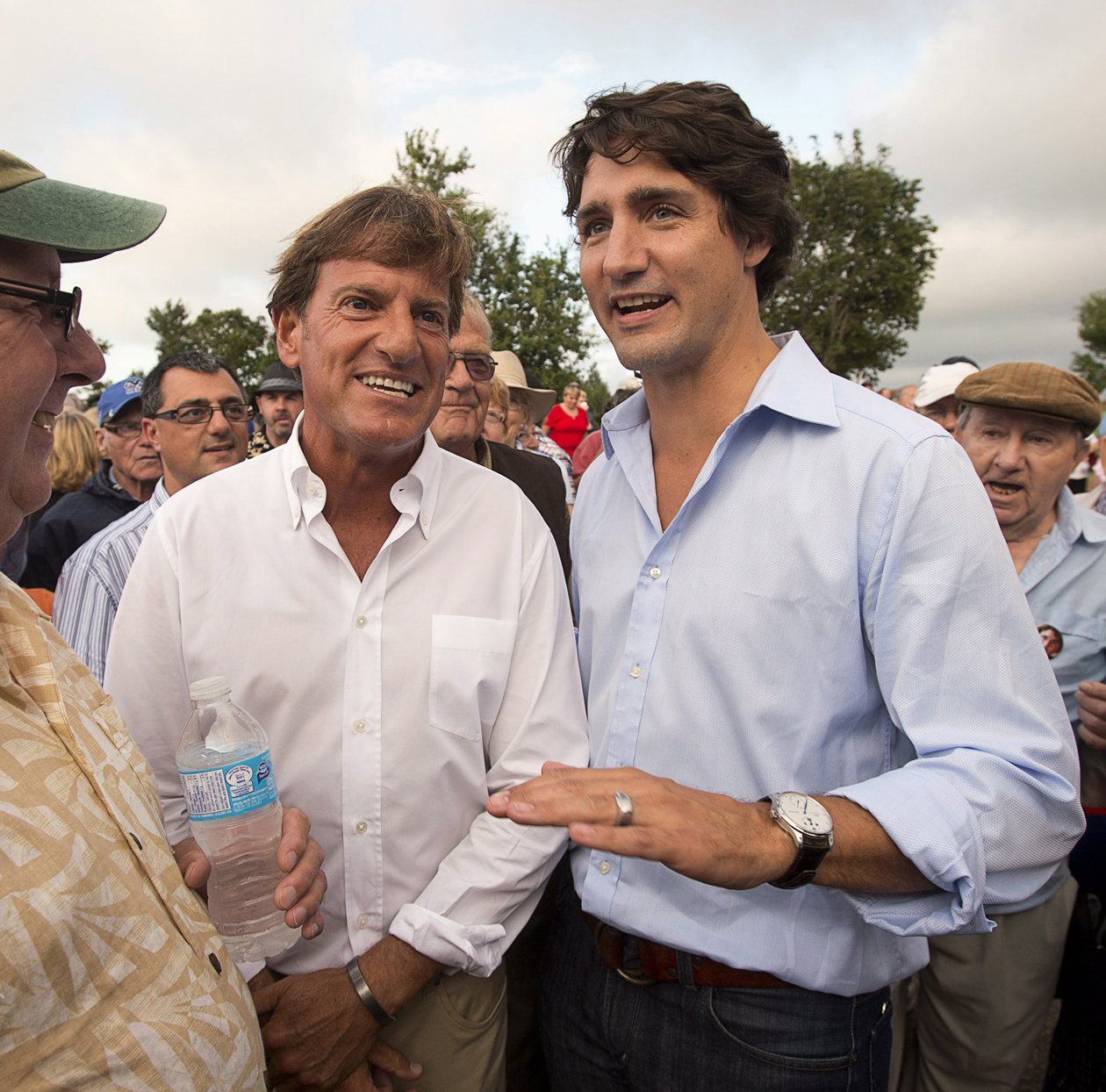
Justin Trudeau and his friend Stephen Bronfman at a barn party in Prince Edward Island, August 2013.
It doesn’t always happen. But in this case the possibly too obvious deduction about at least some progressive Liberal voters moving to the NDP may be more or less correct.
In the capital city of Ontario and environs we have already had our regional early warnings about restless natives in the progressive wing of the federal Liberals. See Bob Hepburn’s “Trudeau at crossroads on two-year anniversary: Hepburn … Liberal rank-and-file increasingly uneasy with Justin Trudeau’s leadership” – published in the Toronto Star on Saturday, April 4, 2015.
2. Some current dilemmas of progressive Liberal voters
For evidence (probably quite brilliant as well as untrustworthy for Justin Trudeau) of what does sometimes seem like a recent rightward leaning among the federal Liberals currently in charge, note John Ibbitson’s April 15 Globe and Mail musing : “A coalition? Why Trudeau has more in common with Harper than Mulcair.”
(Apologies for not supplying a link here : I have only a few more free articles on this site, and, well … I think the answer is … Â Anyway, for some related media spinning, see also the cover of the April 20, 2015 print edition of “Maclean’s … Canada’s National Magazine.” It promises : “The Truth About Stephen Harper’s [Surprisingly Liberal] Economic Record.”)
In the broader and more serious coalition debate as well, a typical progressive federal Liberal voter might have found Justin Trudeau’s recent performance in the ongoing unite-the-left co-operation mumble less impressive than that of both Thomas Mulcair and his former NDP leadership rival Brian Topp, less than two weeks before.
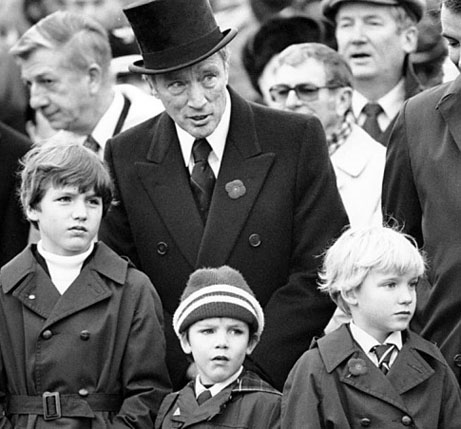
Pierre Trudeau with sons (left to right) Justin, Michel and Sacha on Remembrance Day in Ottawa in 1981. (National Archives of Canada.) This too has been part of Justin’s on-the-job training – and his father ran a minority government with support from David Lewis’s NDP 1972—1974 : some would say, Pierre Trudeau’s best years in office!
On the Liberal leader see the April 15 Canadian Press report : “Justin Trudeau rules out coalition with NDP after saying he may be open to it.”
I had myself  – if I may say so – already obscurely tried to report on the virtues of the Mulcair and Topp coalition act, just this past April 3, in “Of course as current third party the NDP is bound to talk up some kind of Liberal-NDP co-operation, but ..”
I can’t remember who thought up that wordy title! But I do vaguely recall writing that even if the “recent NDP musings” about the possible need for a Liberal-NDP or NDP-Liberal alliance after this fall’s federal election were “just a strategy designed to attract” disaffected  Liberals, “the strategy may be working.” I still agree with my earlier self on this.
3. Inescapable logic of progressive co-operation in (the right kind of) minority parliament
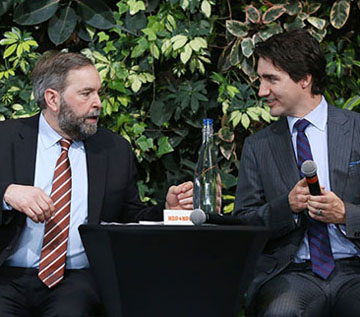
Justin Trudeau, right, Liberal Party Leader and Thomas Mulcair, Leader of the NDP participated in the iVote, Youth vote/political engagement event on Tuesday, March 25, 2014, organized by Kevin Page at the University of Ottawa. Photograph by: Jean Levac, Ottawa Citizen.
There is of course still a lot of time between now and the October 19 election (it grows harder and harder to see any other alternative to the prescribed date in the written law  – whatever the unwritten law might say?). Many things could change.
Yet as matters stand, with the parties in their present increasingly close poll rankings (allowing that the NDP remains a good length or so behind the other two), the prospect that no party will have a working majority of seats in the Canadian House of Commons after the election does seem even more than likely.
It also, again on the current numbers at any rate, seems likely enough that all three major parties will finish with substantial numbers of seats in the new 42nd Parliament of the 1867 confederation.
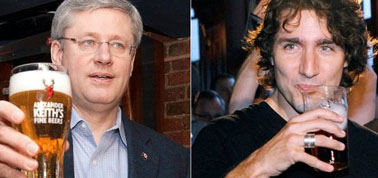
Back in late 2013 an EKOS Research poll found that 44% of Canadians would most like to have a beer with Justin Trudeau, compared to only 22% who picked Stephen Harper for this purpose. (Even Mulcair did better than Harper, at 24%.) Somehow the Trudeau Liberals have to convince the country that what it needs right now is a prime minister who it would be fun to have a beer with. And who knows? That may even be half-true!
Nothing anyone said six months ago (ie now) about virtually anything is going to be held against them, Â or ought to be, Â then.
And, if you are a sensible progressive Liberal voter determined to keep looking on the bright side, Justin Trudeau has at least been confusing enough in his latest pronouncements to leave  some wiggle room for accommodating future realities that may be less than the Liberal Party of Canada might have liked, but are still very good.
4. Trudeau’s best strategy : buy shares in the Nanos Index ????

Some women in Justin Trudeau’s life : (Left to right) Sophie Gregoire Trudeau, his wife ; Estelle Gregoire, his mother-in-law ; Margaret Trudeau, his mother ; and Alicia Kemper, his sister from his mother’s second marriage.
Whatever else, it does seem undeniable that the Trudeau Liberals have lost ground on some fronts in the more recent past. And Justin Trudeau and his advisors are no doubt receiving too much advice on what ought to be done.
Apart from just shouting BE MORE PROGRESSIVE, all I have to offer gratuitously in this context is the night thought that the Trudeau Liberals might gain some ground if the leader asked his attractive wife to become more involved in the campaign.
My sense is that certain sides of the country today – present in all regions, both official languages, and almost all cultural groups – are almost literally thirsting for some vaguely hip new political leadership, that will make various Canadian locations look good again in the eyes of the global village.
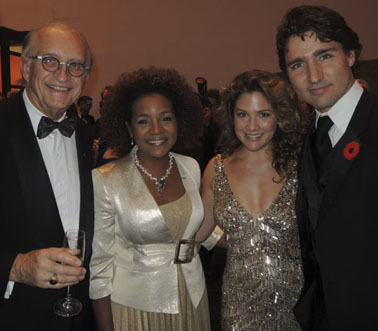
Jean-Daniel Lafond, Michaëlle Jean, Sophie Grégoire et Justin Trudeau. PHOTO: HERBY MOREAU, LA PRESSE.
It’s always seemed to me (well since April 14, 2013 at any rate) that Justin Trudeau, almost just by his photograph, at least suggests the image of a politician who can slake this particular thirst among the diverse populace. And I think his wife strengthens this image.
If the federal Liberals themselves were crazy enough to pay for my advice at this juncture, however, the first thing I’d advise would be : don’t go overboard with grief just yet.
I’d point in particular to an article first posted on the CTV News website around dinnmertime on Tuesday, April 14, 2015 : “NDP, Conservatives tied on latest Nanos Index.”
More exactly I’d underline the latest essential April 14—15 message from seasoned pollster and pundit Nik Nanos : “The New Democrats have tied the federal Conservative Party on the Nanos Party Power Index for the first time since September 2014… The Tories continued their downward trend, dropping for the third week in a row and leaving them at 51 out of a possible 100 points.”
The complete latest % numbers for the Nanos Party Power Index here go : Liberals: 58 (up one point from last week) … Â Conservatives: 51 (down one point from last week) … NDP: 51 (unchanged) … Greens: 34 (up one point from last week) … Bloc: 25 (down one point from last week).”
5. L’envoi … just how sad or glad should Justin Trudeau be right now ????
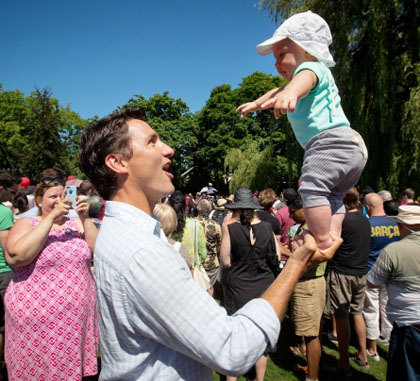
Federal Liberal leader Justin Trudeau balances his five-month-old son Hadrien on his hand while attending BC Day Liberal barbeque in Vancouver, early August 2014. Photograph by DARRYL DYCK , THE CANADIAN PRESS. This is one kind of thing that seems to win him votes. If his five-month-old son trusts him like this, maybe he actually can run the country.
Naturally you might reasonably ask : what is the “Nanos Party Power Index” anyway?
As the Nanos website itself explains, it “comprises a basket of political goods that includes ballot preferences, accessible voters, preferred PM views and evaluations of the leaders. It is modeled similar to a standard confidence index. It is a random telephone survey conducted with live agents, reaching out to Canadians through a land-and cell-line dual frame sample.”
Is there any possibility that what Mr. Nanos is measuring here, in his “Party Power Index,” will somehow prove a better predictor of what will finally happen when the election comes, than raw opinion polls on just what party would you vote for if the election were held today?
I don’t myself know, of course. But it must be part of Nik Nanos’s argument for reporting on his composite Index as he does that he believes it provides better intelligence on what would finally happen if an election were held today … and voters behaved as they do when push comes to shove inside the polling booth …
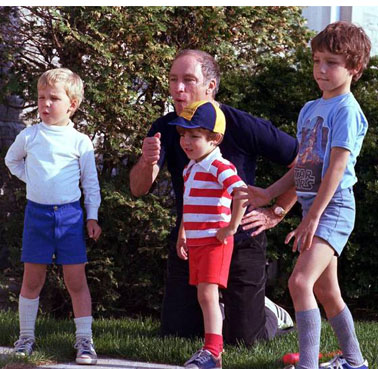
Prime Minister Pierre Trudeau with his three sons (left to right), Sacha, Michel and Justin on May 11, 1979. (Peter Bregg/Canadian Press.)
If this argument is even remotely serious, Justin Trudeau has at least one reason to be glad. The Nanos Party Power Index on April 15, 2015 is still putting him clearly ahead in the pack. And the Conservatives and New Democrats are tied! The current version of another somewhat unusual number that Nanos regularly reports on is interesting too :
“Asked a series of independent questions as to whether they would consider or not consider voting for each of the federal parties, 53 per cent of Canadians would consider voting Liberal while 45 per cent would consider voting NDP, 41 per cent would consider voting Conservative and 30 per cent would consider voting for the Greens.”
6. None of the above?

The “real” Éric Grenier – “founder of ThreeHundredEight.com, a website dedicated to political polling in Canada and electoral forecasts.” And now working for the CBC.
Meanwhile, one popular interpretation of what is going on in the Canadian federal election campaign right now keeps ringing in my ears.
I heard it in an informal focus group, meeting at an old second-floor watering hole overlooking the main street downtown : “At this moment none of the party leaders really look attractive.”
And maybe that’s what the numbers are finally telling us too!
The real people’s choice right now is none of the above. Not even the once more charismatic Justin Trudeau. (And I still think myself that the best possible result in the fall will somehow throw the two federal leaders from Quebec together [well, Quebec and BC in Trudeau’s case, arguably enough] – whether they like it or not!)
